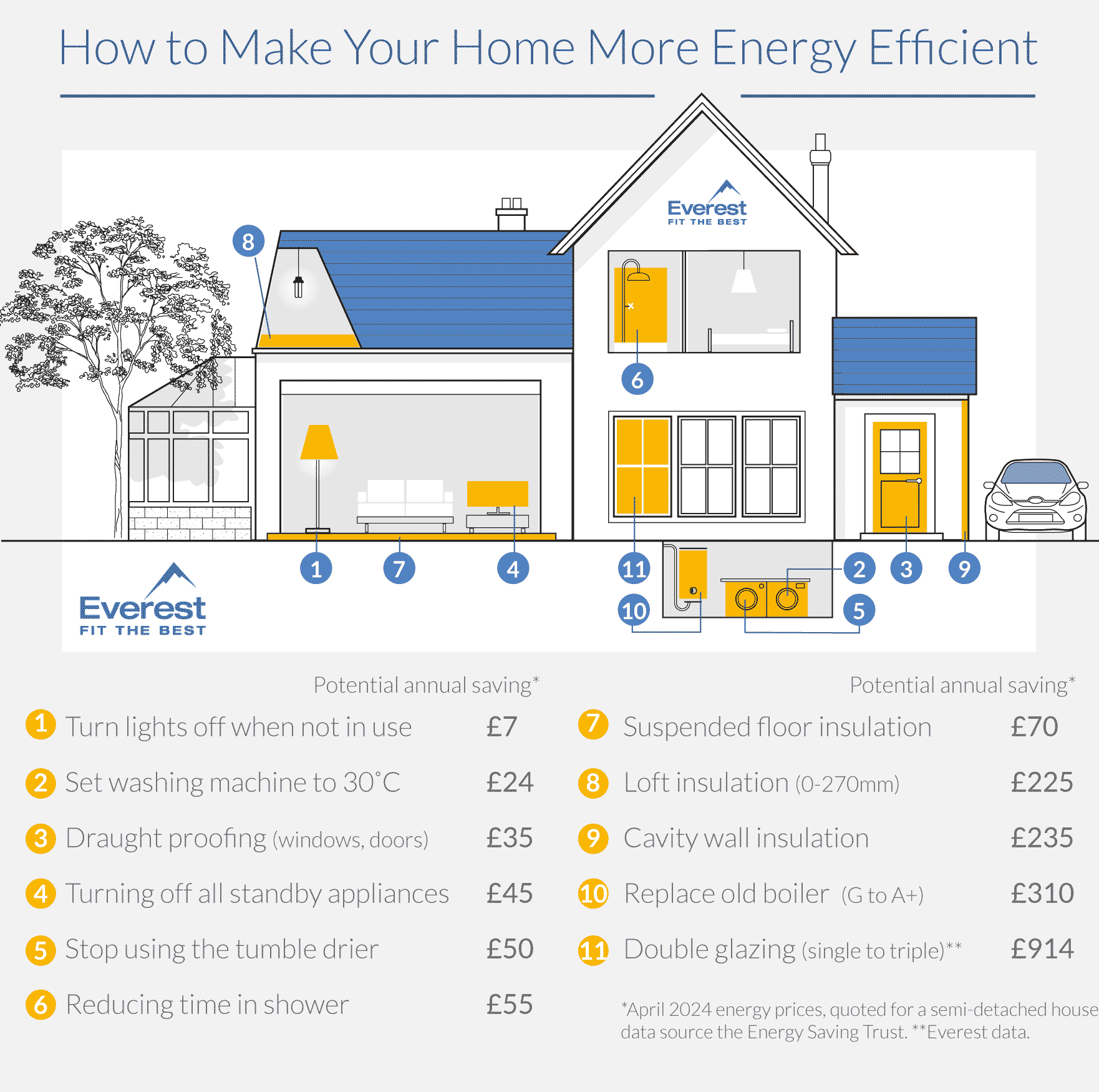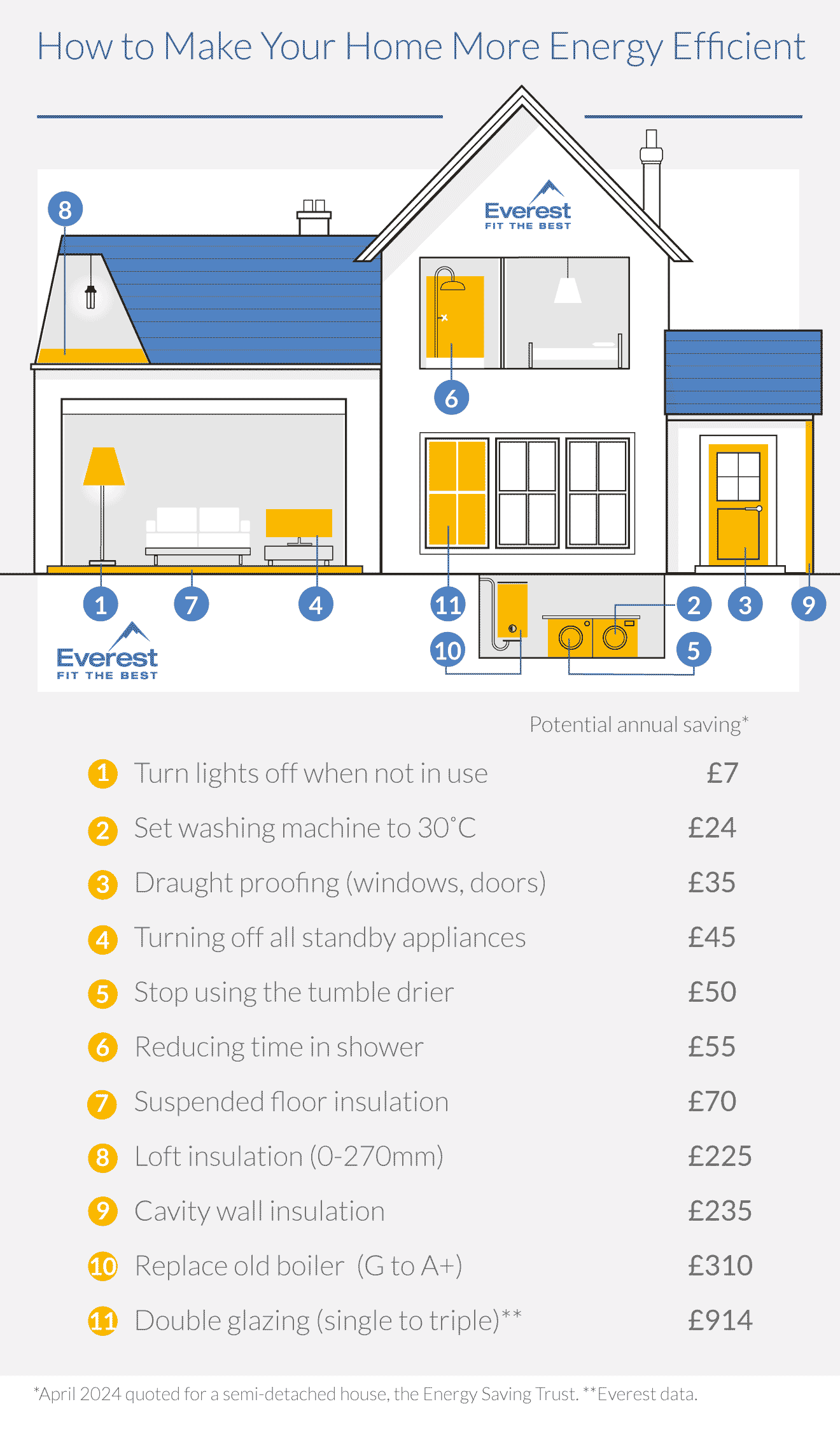

How to Make Your Home More Energy Efficient
To make your home more energy efficient, there are five key areas to review and improve:
- Insulation
- Draught proofing
- Light
- Heat
- Hot water
If you don't have an EPC (as mentioned above), you can make an assessment of your house by reviewing these five main areas and following the recommendations below.
When considering what to do first to make your home more energy efficient, consider that a leaking bucket will keep losing water however much you keep pouring in.
Therefore, tackling insulation in your home should be a priority to make sure that as much heating as possible is kept in the house and you are not paying to see your heat go through the roof (so to speak).
![How to make a house energy efficient - insulation]()
Insulation
Wall Insulation
A third of the heat from a house can be lost through the walls if they are not insulated. Terraced houses or apartment blocks are the most efficient as they benefit from being insulated by their neighbours. Detached houses are the most inefficient as they have four walls and a roof exposed.
Most houses built after 1990 will have insulated walls and do not need extra insulation. Houses built between 1920 and 1990 will usually have cavity walls and houses built before 1920 will usually have solid walls.
Cavity wall insulation is relatively easy to install but there is an important caveat that with houses exposed to excessive wind and rain, it might be unsuitable. Insulation that suffers water ingress will develop dampness and mould and this can be a significant health problem. Make sure to take advice from a qualified and reputable installer as a bad installation can be costly to rectify.
For solid walls that don't have a cavity, the external walls can be clad and/or internal walls clad with insulating material. This is a more intrusive and costly investment than cavity wall insulation.
Cavity wall insulation can save up to £235 annually for a semi-detached house. Solid wall insulation can save up to £315 annually for a semi-detached house.
Floor Insulation
Draughts from floors or cold floors can not only reduce the temperature of a room, but they will also make you feel more cold. By insulating floors, it will make you feel warmer and help with warmth retention in the room.
Upper floors don't usually need floor insulation as they will benefit from heat from the room below unless they are built over a void. Insulation only needs to be applied to the ground floors.
Older houses can have suspended floors and floorboards and often have gaps and plenty of draughts. As a starting point, try to seal gaps where you can and use rugs to keep floors feeling warmer.
Suspended floors can be insulated with rock wool between the underside of floorboards held in place with netting.
Newer homes will have concrete floors and these can be insulated with solid insulation boards laid on the floor and under flooring.
Suspended floor insulation can save £70 a year for a semi-detached house.
Loft Insulation
Heat rises and in a house, a quarter of heat is lost through the roof. One of the easiest and most effective ways to make a house more energy efficient is by installing loft insulation.
The recommended depth of rock wool is 270mm.
For a house that doesn't have insulation and installs 270mm of rock wool the energy saving can be a big saving of £225 annually for a semi-detached house.
Roof Insulation
As an alternative to loft insulation, or for converted loft spaces, the underside of the roof can be clad internally with insulation boards. Any gable walls will also need to be clad and insulated to be effective.
Hot-water Cylinder Insulation
Adding insulation to a hot water tank and water pipes is a quick and easy job that anyone can do. A cylinder jacket will retain heat so that it takes your tank less time to heat water each time and saves energy use. The minimum thickness of insulation should be 80mm.
Lagging pipes will not only insulate the hot water but also protect them from cold and the disruption of burst frozen pipes. Foam tubes can be bought from any DIY store and fitted quickly and easily.
Insulating an old uninsulated hot water cylinder with a minimum of 80mm could save you £180 a year. Increasing insulation from 25-80mm will save £45 a year.
Energy Efficient Windows with Low U-value
Energy efficient windows are constructed so they reduce as much heat loss as possible. The glass, the frame and the construction all contribute to how efficient the window is.
U-values measure the energy transfer through solid materials and the lower the U-value the more energy efficient the window is.
Choosing windows based on a low U-value of 1.4 or less will mean less heat loss from a room and less energy use and saving money on energy bills.
Everest Double Glazing has a U-value of 1.3 and Everest Triple Glazing has a U-value of 1.0.
Note that for replacement windows in an existing building, Building Regulations require a U-value of 1.4 or less.
Replacing single glazing with triple glazing can save up to £915 a year on energy costs. Replacing old double glazing to triple glazing can save up to £365 a year on energy costs - read more about energy efficient windows.
Energy Efficient Doors
Like windows, doors allow heat to escape and if they are not fitted snugly in a frame can have significant drafts around the edges.
An energy-efficient doorset will have an integrated draught proof frame, letter box and glazing. The door slab will also be insulated for minimum heat transfer.
Building Regulations require a door in an existing dwelling to have a U-value of 1.4 or lower.
Draught proofing windows and doors can save £35 a year.